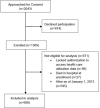Care in the last year of life for community patients with heart failure
- PMID: 25834184
- PMCID: PMC4439290
- DOI: 10.1161/CIRCHEARTFAILURE.114.001826
Care in the last year of life for community patients with heart failure
Abstract
Background: Healthcare utilization peaks at the end of life (EOL) in patients with heart failure. However, it is unclear what factors affect end of life utilization in patients with heart failure and if utilization has changed over time.
Methods and results: Southeastern Minnesota residents with heart failure were prospectively enrolled into a longitudinal cohort study from 2003 to 2011. Patients who died before December 31, 2012, were included in the analysis. Information on hospitalizations and outpatient visits in the last year of life was obtained using administrative sources. Negative binomial regression was used to assess the association between patient characteristics and utilization. The 698 decedents (47.3% men; 53.4% preserved ejection fraction) experienced 1528 hospitalizations (median 2 per person; range, 0-12; 37.6% because of cardiovascular causes) and 12 927 outpatient visits (median 14 per person; range, 0-119) in their last year of life. Most patients (81.5%) were hospitalized at least once and 28.4% died in the hospital. Patients who were older and those with dementia had lower utilization. Patients who were married, resided in a skilled nursing facility, and had more comorbidities had higher utilization. Patients with preserved ejection fraction had higher rates of noncardiovascular hospitalizations although other utilization was similar. Over time, rates of hospitalizations and outpatient visits decreased, whereas palliative care consults and enrollment in hospice increased.
Conclusions: Although patient factors remain associated with differential healthcare utilization at the end of life, utilization declined over time and use of palliative care services increased. These results are encouraging given the high resource use in patients with heart failure.
Keywords: death; heart failure; hospitalization; residence characteristics; skilled nursing facilities.
© 2015 American Heart Association, Inc.
Figures




References
-
- Go AS, Mozaffarian D, Roger VL, Benjamin EJ, Berry JD, Blaha MJ, Dai S, Ford ES, Fox CS, Franco S, Fullerton HJ, Gillespie C, Hailpern SM, Heit JA, Howard VJ, Huffman MD, Judd SE, Kissela BM, Kittner SJ, Lackland DT, Lichtman JH, Lisabeth LD, Mackey RH, Magid DJ, Marcus GM, Marelli A, Matchar DB, McGuire DK, Mohler ER, 3rd, Moy CS, Mussolino ME, Neumar RW, Nichol G, Pandey DK, Paynter NP, Reeves MJ, Sorlie PD, Stein J, Towfighi A, Turan TN, Virani SS, Wong ND, Woo D, Turner MB. Executive summary: Heart disease and stroke statistics--2014 update. Circulation. 2014;129:399–410. - PubMed
-
- Desai AS, Stevenson LW. Rehospitalization for heart failure: Predict or prevent? Circulation. 2012;126:501–506. - PubMed
Publication types
MeSH terms
Grants and funding
LinkOut - more resources
Full Text Sources
Medical

